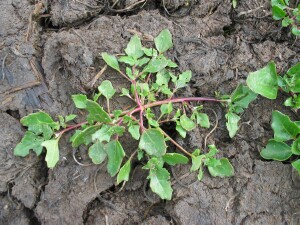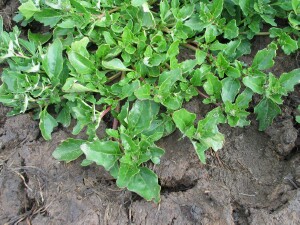Glaucous Goosefoot
Back | Salinity Indicator Plants Home | Common name home | Scientific name home | Photo Gallery | Glossary
| Glaucous Goosefoot photos | Family: Saltbush (Chenopodiaceae) |
| Scientific Name: | Chenopodium glaucum |  Glaucous Goosefoot plant Photo: A J Brown | ||||||
Other Common Name: | Oakleaf Goosefoot, Oak-leaved Goosefoot | |||||||
Status: | Native to Australia but also around the world. | |||||||
Plant Description: | A prostrate to erect annual, herb to about 40 cm high with rhombic to ovate or triangular, thick, fleshy leaves, 10-45 mm long and 8-30 mm wide and slightly but irregularly toothed or gently lobed margins. Lower leaf surface mealy (with a powdery or floury covering) and whitish to grey, while the upper surface is smooth and generally green to reddish-grey. Flowers are clustered in the junctions between stems and leaves, in panicles or racemes. Flowers consist of three parts (tepals) and have 1-3 stamens. Fruit has a thin, membranous covering over a reddish-brown to black, circular seed, 1 mm diameter. | |||||||
Habitat: | Associated with coastal and inland saltmarsh but also occasionally around lake margins and saline or subsaline swamps. Largely on heavy textured soils.
| |||||||
Comments: | Leaves are often grey with reddish edges when the plant is under extreme salt stress. Although this species has been cited as containing a number of subspecies (e.g. subsp. ambiguum in Australia), the differences between them is not clear, and it is likely that naturalised forms also occur here. Other Goosefoots occurring in waste land are also salt tolerant. They include Sowbane (Chenopodium murale) and Fat Hen (Chenopodium album). A similar species often found growing in or on the edges of saline soils is Orache (Atriplex prostata), | |||||||
 Leaves of Glaucous Goosefoot Photo: A J Brown | ||


